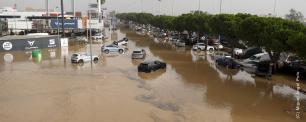How do we cope with extreme weather events such as a DANA?
These days we are shocked by the floods caused by the DANA in Valencia, Castilla la Mancha, Murcia and Andalusia, among other regions. A DANA - the acronym for Depresión Aislada en Niveles Altos - is a common meteorological phenomenon in the Mediterranean, also known as a cold drop, but now it is becoming much more virulent due to climate change and we are already seeing the serious consequences. In addition, we should bear in mind that extreme weather events like this are also becoming more frequent with global warming: if a storm or downpour used to occur every 100 years, now it will happen every 50 years or less. We talk about this with our researcher Annelies Broekman, especially about some of the measures that need to be taken to cope with this situation from a water management and adaptation point of view.

“We need to look very carefully at the flood-prone areas most at risk, such as riverbanks or the seafront, and prioritise renaturation over adding more concrete"
ANNELIES BROEKMAN, CREAF researcher
First of all, the most obvious actions to be taken in the face of this increase in extreme weather events concern urban planning. "We must pay close attention to the flood-prone areas at greatest risk, such as riverbanks or the seafront, and give priority to renaturalising them rather than adding more grey areas. This will increase the resilience of territories to extreme weather events. A well-known case is that of railway lines along the sea, which will have to be relocated. And above all, we must abandon new projects that plan to continue building in flood zones, such as deltas or wetlands", says Broekman. In the same vein, it is necessary to establish spaces for deliberation where all actors in society and scientists can redesign the uses of the territory and review the protocols for reconstruction after the storms. Currently, existing structures are to be replaced, without environmental impact or climate change vulnerability studies. Now is the time to take advantage of the funds to adapt to the new scenario and it is very important to understand that investing in renaturalisation will always be less costly in the long run.
We must improve the management of natural aquatic systems to minimize the impact of these events on society.
Secondly, and going to the heart of the matter, we must think about how to improve the management of natural aquatic systems in order to minimise the impact of these events on society. As our water management expert explains, "beaches, marshes, lagoons... the ecosystems that form part of the coastline protect us from extreme climatic phenomena because they are adapted to them. For example, the dunes on the beaches have a clogging effect, which means that the water from the downpours is recirculated and does not have such an intense impact. The problem is that the Mediterranean coastline is very damaged and is no longer fulfilling some of these natural functions". Therefore, beyond urban planning measures, in order to face the storms that must come, it is important to recover all this nature that protects us: "we must restore the coasts, ensure that the rivers have the ecological flows that correspond to them and that they reach the sea correctly, directing their sediments to the deltas, among other measures".
Ultimately, we need to give nature back the space that is hers. More breakwaters, sea walls or revetments are methods that continue to damage the coast and the natural cycles that occur and will not provide us with a long-term solution, which is what we need. In fact, they are designed with baseline conditions that climate change has already changed. That is why large projects must look for nature-based solutions. It may seem expensive at first, but more expensive is the inaction and replacement of infrastructures that will periodically break down. Thus, recovering nature will not only mean recovering the protective functions it gives us, but will also allow us to adapt more effectively to the future that awaits us.







